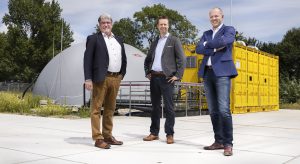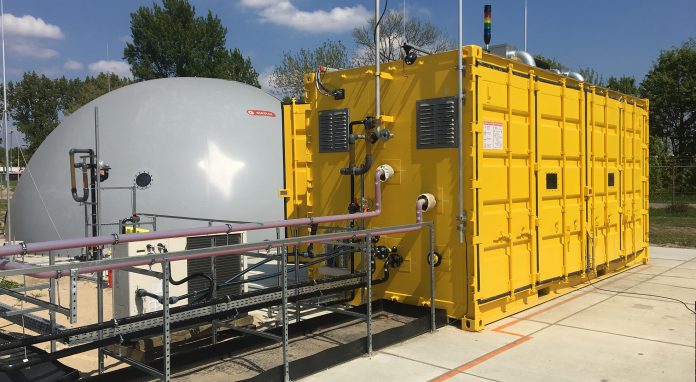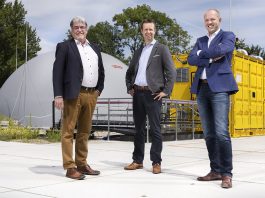Dutch electricity storage company Elestor is reshaping the world of batteries in ways that promise to transform the entire energy system.
“The energy transition will depend entirely on large-scale and low-cost electricity storage. Without it, it will be impossible to fully decarbonise the energy system, as we would then need to carry on burning fossil fuels when the weather is calm and it is cloudy or dark,” observed Guido Dalessi, CEO of Elestor.
Large-scale electricity storage will play a vital role in the renewable energy system. This is where Elestor expects to lead the way.
Wiebrand Kout, Chief Technology Officer, said: “We will soon see the emergence of entirely new power plants with hydrogen bromine flow batteries at their heart.”
In this energy system, Kout envisages that solar and wind parks will serve as sources of energy that will take over the roles currently played by coal mines and gas fields.
“The batteries will then become the new power plants as they balance the supply of electricity to match demand, just as coal or gas fired power stations do today,” Kout continued.
Lightbulb moment
Elestor’s solution emerged from Kout’s original and since patented invention. He began developing it about a decade ago, when he started searching for answers to questions that were rarely asked.
“Change starts in the mind. As we question and challenge conventions, we think of ways to solve both existing and new challenges,” said Kout.
“So, I wanted to identify how we can store electricity at a massive scale without breaking the bank, and how we can scale a new energy system quickly without destroying the planet.”
The solution would have to be an electrochemical flow battery system, he concluded, as these are suitable for chemicals that are both cheap and abundant, unlike much of the material used in lithium-ion batteries, for example.
At the time, hydrogen was already used, although it was mostly produced from natural gas, while batteries were about to become mainstream in automotive applications and beyond.
Kout was eager to develop a solution that would bridge the two technologies. He explored several alternative chemistries, but the lightbulb moment came when he had a conversation with fellow scientist Dr Adam Weber from Lawrence Berkeley National Laboratory, during an electricity storage conference in Spain.
As Dr Weber explained the pros and cons of hydrogen (H2) bromine (Br2) flow battery cells, Kout found himself enthused by their potential benefits, while at the same time questioning how to overcome all the obstacles.
Both an electrolyser and a fuel cell
Kout returned to The Netherlands and put pen to paper. He soon came up with a solution centred on a flow battery containing the two active materials, hydrogen and bromine.
“The two chemistries are separated by a membrane within a closed system, which means nothing other than electricity enters or exits the battery – as is the case with conventional batteries,” Kout explained.
Within the flow battery cells, there is plenty of action in a confined space, however. The power density (kilowatts per square metre cell area) of the two chemicals is pretty high when compared with other flow batteries.
The storage system is centred around a cell stack that is made up of several individual electrochemical cells. Each cell has a membrane that is in direct contact with the electrolyte circuit, an aqueous solution of hydrogen bromide (HBr) and bromine (Br2) on the one side, and a hydrogen gas (H2) circuit on the other. Both the active materials circulate in a closed loop within their respective sides of the cell. The membrane separating the materials is a proton-conductive membrane, which combines two electrochemical processes.
When connected to a power source, so whilst charging, the hydrogen bromide (HBr) molecule is split into a bromine Br – ion and a proton (H+) ion. The Br – ion remains in the electrolyte reservoir, while the proton (H+) ion crosses the membrane and absorbs an electron to form hydrogen (H2).
Reverse the process, by discharging, and the battery will return the electricity stored in hydrogen form. The hydrogen gas molecule releases two electrons and forms two proton (H+) ions that return to their original location within the flow battery pack where they form HBr in the electrolyte circuit.

To simplify this, think of flow batteries as a tipping scale, where protons flow to one side during charging, then to the other during discharging. After all, for most people, the complex process that goes on inside a battery is irrelevant, as long as it works, and Elestor’s batteries certainly deliver as they are cheaper, more robust and longer lasting than most other batteries available. Whilst they are too heavy for cars and impractical for your torch or your radio, the practical benefits for specific applications are immense. These batteries are meant to store vast amounts of electricity generated in wind or solar parks.
It is, however, important to understand one significant point here. The cells in a hydrogen flow battery operate as electrolysers that produce hydrogen when the battery is being charged with electricity from an external source, and as fuel cells that return this electricity while it is being discharged, and in between these two processes the electricity is stored.
Leap into the unknown
Happy with his findings, Kout was ready to pursue his dream to develop technology that could help combat the air quality and climate change crisis facing the world.
“I’ve long been convinced that our civilisation is doomed if it continues on its present path. We simply cannot keep treating the atmosphere as an open sewer,” he said.
Kout’s long-held desire to make a difference posed a fresh challenge, however. Prior to becoming an inventor with a mission, he had already worked on some significant hydrogen innovations. Notably, he built his first fuel cell with an AkzoNobel spin-off called NedStack as part of his Bachelor’s thesis in 1999. Then, at startup HyET, his team developed an electrochemical compressor that could compress hydrogen to 1,000 bars – a mammoth jump from the previous record of just 20 bars. But Kout had never before created a company, so it was a big step for him to quit his job and start Elestor in 2014.
“It did require some intense discussions with my wife,” Kout recalled.
A multi-disciplinary approach to flow batteries
Armed with fundamental insight into industry trends, such as the rapidly falling prices of solar and wind power, the anticipated scarcity of raw materials such as lithium and cobalt used by other battery inventors, and boxes of scribbles and drawings put together during evenings and weekends, Kout persuaded his wife that it was a risk worth taking. He then took the leap into the unknown, and he has not looked back since.
From the start, Kout focused on making pragmatic and practical applications of proven scientific concepts affordable. Kout set out to develop a three-step cost-reduction structure. His first criteria was that the energy transition must be affordable and therefore delivered at costs below those of gas, oil and coal. Therefore, the chemicals used must be readily available and thus cheap.
Hydrogen and bromine were chosen because they are abundantly available, and because both their high power density (kW/m2) and high energy density (kWh/m3) help deliver the lowest possible storage costs per kWh.
Kout commented: “Perhaps we could have done something similar with more expensive and less dense chemistries, but such solutions would quite simply have been uncompetitive.
“Hydrogen and bromine are abundantly available across the world. The supply is not restricted by geographical availability, and – unlike lithium, cobalt and vanadium – they cannot be dominated by a small group of suppliers.”
Kout’s second criteria centred around the technology’s scaleability and longevity, which was obviously anchored in the abundance of the materials used, though the ease of manufacturing robust real-world solutions was an equally important factor.
“We needed to make sure the low-cost materials remained so also in future, for decades or centuries to come, even as large volumes would be required for high volume production of hydrogen bromine flow batteries. And then, we needed to make sure the flow batteries were quick, easy and affordable to manufacture,” Kout added.
The third and final criteria demanded a simplified design system that was robust, had a long lifetime, delivered power quickly and did not have any self-discharge. Elestor has “learned the hard way” and, over time, solved this challenge with a patented solution.

Appealing investment
Beyond the scientific and practical proof points, Kout’s keen eye on costs naturally made investors’ ears prick up.
In the world of clean energy investment, there is generally no shortage of tech-savvy entrepreneurs with visions of leaping from pure to applied science. Yet, too often these scientists ignore the harsh reality that subjects such as communications, business and economics can be as powerful of forces as electronics, chemistry, and physics. But Kout’s proposition was different.
“I knew that, to be successful, I had to develop the cheapest electricity storage solution the world had ever seen, then make it even cheaper.
“This is exactly what we’ve done. Our research and development activities have not only expanded every year since I founded the company. It has also been very broad as I’ve tried to ensure any scientific leaps are both practically achievable and affordable for customers,” Kout added.
European investment company EIT InnoEnergy, which helps people realise ideas that can help power the energy transition, soon stepped in to back Kout’s entrepreneurial journey.
In the years ahead, Kout’s ability to benchmark all developments against cost attracted a string of investors, initially from Guido Dalessi who also stepped in as Chief Executive Officer.
“Prior to joining Elestor in 2015, I had analysed the propositions of several tens of high-tech startup companies, yet I had never come across anything as promising as Elestor’s technology.
“When Wiebrand told me about his vision and ambitions, I realised that I had come across a technology that was emerging at exactly the right time, so I was honoured when he asked me to jointly build a company that could make it a commercial reality,” Dalessi said.
Enfuro Ventures got onboard next, followed by Kees Koolen of Booking.com fame and his clean energy group Koolen Industries.
Kees Koolen, Founder and CEO of Koolen Industries, said: “The technology Elestor developed is an elegant solution to the challenge of large-scale electricity storage. As an investor, I’m always thrilled when a group company is able to make the jump to a next growth phase.”
Elestor was soon being noticed beyond its relatively narrow field. In 2021, The University of Amsterdam’s Centre for Business Innovation ranked Elestor as one of the ten most innovative companies in The Netherlands, in the Dutch Innovation Award competition, which was entered by 600 companies.
Then, this summer, a consortium led by the corporate venture arm of the Norwegian energy giant Equinor got involved. The consortium, which also included Vopak’s venture capital arm, Dutch impact investor Invest-NL and Somerset Capital Partners, injected €30m to help Kout, Dalessi and van Bennekom deliver exactly the kind of energy transition the world is desperate for.
Gareth Burns, Head of Equinor Ventures, said: “Technologies providing long-term energy storage at scale will play an important role in satisfying the growing need to stabilise power markets. We look forward to working together with Elestor.”
Shape of things to come
Elestor’s technology is eminently scaleable, not just because the chemicals are abundant but also because they can be stored in vessels or reservoirs of almost any size. They are also perfectly safe, since the chemicals remain in the 100% self-contained system at all times, and because they are never handled by humans, which rules out risks related to human error.
As such, Elestor’s breakthrough is in fact a shape-changer for batteries. There is no particular need for Elestor’s flow batteries to be either square or cylindrical, which are common formats for conventional batteries.
Indeed, the hydrogen and the bromine can be stored in enormous tanks, including in tanks previously used to store other chemicals. The greater the tanks, the more energy can be stored, measured in megawatt hours (MWh). The bromine and hydrogen tanks must obviously be connected, but the chemicals are then separated by the membrane stacks, and the larger the membrane the more power, measured in megawatts (MW), available.
Last year, Elestor partnered with one of the world’s leading independent tank storage companies, Royal Vopak. The joint ambition is to scale up the electricity storage capacity of these flow batteries to 3,000 kWh and then further develop it to industrial scale. This development is part of Vopak’s New Energy strategy. Their joint ambition is to scale up the electricity storage capacity of flow batteries, initially to 3,000 kWh, then scale it to industrial levels, up to hundreds of MWh.
Patrick van de Voort, Division President Europe & Africa at Vopak, said: “This development is part of Vopak’s New Energy strategy.
“Developing large-scale and low-cost electricity storage will become increasingly important and, with this promising technology, electricity can be stored in molecules on a large scale. We are looking forward to jointly developing these flow batteries.”
Similar solutions are currently under investigation, together with companies that own gas fired power stations, as they are eager to remain relevant and avoid ending up with stranded assets once a decarbonised energy system takes over.
Societal requirements
Elestor has obviously come far, but it refuses to stand still. The company is continuously expanding its research and development initiatives to solve a growing number of challenges posed by fast-growing global demand.
Individuals, communities, companies and politicians obviously want zero-carbon electricity at the flick of a switch, and they want it delivered with a minimal impact on nature, air quality and the climate. However, they are not technology experts, so it is not their role to pick winners in the competitive race between clean energy technology providers. To lead the race, Elestor has sought to identify optimal electricity storage periods suited to weather patterns and societal demands.
Hylke van Bennekom, Chief Operating Officer of Elestor, said: “This is a good example of how diversified and broad our solutions-focused approach is.
“Our teams of experts have combined their insight into what is possible within nature’s physical and chemical restrictions with what is required in a world where both the supply of and the demand for energy is dictated by the weather and by the time of day, day of the week, or the seasons.”
The challenge here is to balance the cost of wind and solar power generation capacity with the cost of energy storage duration, as it is obviously cheaper to avoid building too much of either.
“The most economic option for a 100% carbon-free electricity supply requires storage of typically 100 hours, which equates to normal no-wind periods,” explained Kout.
Hydrogen infrastructure
Elestor has also focused in on opportunities arising from an anticipated rollout of hydrogen infrastructure that will be required by industry and the transport sector.
As its flow battery generates hydrogen during the charging process, there are several new and unique possibilities for integration.
“Once a hydrogen infrastructure is in place, our energy storage solution can do away with the hydrogen side of our battery. Instead, we can plug into hydrogen gas pipes that feed the battery during charging,” explained CEO Dalessi.
“Then, during discharging, the exact same volume of hydrogen is taken again from the gas pipe, so the net consumption is zero. Consequently, a hydrogen storage vessel is no longer necessary, and the system’s footprint is largely reduced. In addition, the CaPex of the system is reduced, which is reflected in further reduction of the storage costs.”
This unique integration with hydrogen infrastructures and electrolysers unlocks several new opportunities. As such, the Elestor technology bridges the two worlds of energy storage: with batteries and in the form of hydrogen.
Market opportunity
Cost reduction and revenue opportunities also arise as a result of renewable energy’s reliance on sunshine and wind.
Dalessi said: “During periods of lots of wind and sun, there is usually a surplus of renewable energy. Then, when it is dark or cloudy and the weather is calm, there will be a demand for any energy stored.
“Our energy storage solution will thus be transformed into a bi-directional power plant that helps balance the electricity system.
“The best bit is that an operator of such a power plant will be buying electricity from solar parks and wind farms when demand, and thus prices, are low, then selling that same electricity later when demand, and thus prices, are high.”
Bright future
Elestor is clearly on a roll. The world already produces plenty of renewable energy. New solar panels and wind farms are added at breakneck speed. In addition, there are ever more new ways to use this clean energy. More and more things in society are electrified, whether we are talking about cars, industrial machinery, or the heating of homes.
But what is still missing is a solution that makes it possible to store electricity on a massive scale at a cost level that makes renewables price-competitive when compared with fossil fuels such as coal, gas, and oil.
Elestor has come up with such a solution, and has even taken developments one step further by futureproofing its solution by making it possible to integrate it into an anticipated hydrogen infrastructure rollout.
The challenges are great, as are the opportunities. Elestor’s founder and team are not afraid to think big and its batteries are as great as the ideas they reflect.
Please note, this article will also appear in the eleventh edition of our quarterly publication.








